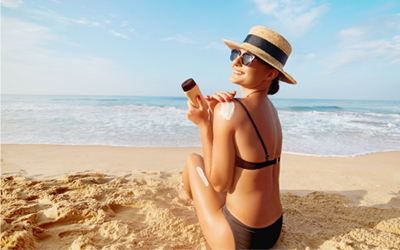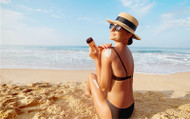Safe Sun Care
Posted by Kristen Woodson, Delasco on May 27, 2022, 3:13 pm

Today, approximately 9,500 people in the U.S. will be diagnosed with skin cancer.
Having 5 or more burns DOUBLES your risk of Melanoma.
According to the American Academy of Dermatology, 1 in 5 Americans will develop skin cancer in their lifetime.
Indoor tanning beds cause 400,000 cases of skin cancer in the US EVERY YEAR.
Skin cancer is the #1 cancer in the U.S.
If those statistics don’t make you jump out of your seat and go reapply sunscreen, I don’t know what will! The sun is a powerful star that can help us by putting off Vitamin D and lifting our mood, however it is also one of the most harmful things when we are overexposed to its damaging rays.
So, what happens in our bodies and in our skin when we get a sunburn?
When we get a sunburn, our skin soaks up too much of the UVA & UVB rays our sun puts off, which means when we get a sunburn, we are really getting a radiation burn. The UVA rays actually penetrates deeper into our skin than the UVB rays and damages the proteins and membranes that are in our skin. Damage done by the UVA rays causes some of our DNA to incorrectly link together! This stops DNA replication, so our cells cannot repair or fix mistakes in our DNA chains. This causes “errors” and too many errors mean our cells get overwhelmed and cause them to self-destruct or completely remove cells that cannot be replicated. If replication cannot happen, the cells die.
Ok, that’s kind of heavy…
You’re right! If we have cell dying all the time, plus we also eliminate extra cells that are not ready to “die off” yet, that’s a major problem for our skin. We can see this physically; we start to see accelerated signs of aging, like leathery, sagging, wrinkled skin way too early. Hyperpigmentation develops and we can see blotchy, uneven tone and even more texture in our skin after a burn.
Let’s go back to sunburns – did you know our bodies start to heal a sunburn even while we are still in the sun? When a burn is detected, our bodies begin producing molecules to attract immune cells to the damaged skin – this is called immune cell invasion! This process peaks 24-48 hours later, which is why the redness and painfulness of a sunburn can keep developing over the next couple of hours. Dead cells will begin lifting and shedding off (peeling) a few days after this process peaks. When you feel the itchy sensation from a burn, that’s the immune cells starting to clean up the damaged cells and they can release chemicals that cause the itchy-ness and other sensations that mimic an allergic reaction! Crazy…
What if I get a burn that is so bad I get blisters?
First off, OUCH! If your burn is bad enough for blisters, DON’T POP THE BLISTERS! Do not lance the blisters and drain them. Let the inflammation and fluid go down on its own.
Sunspots & Hyperpigmentation
When inflammation subsides from a burn, melanin rushes in to help protect that area of skin from further UV damage. Therefore we see new freckles, sunspots, and even new macules after a burn. Melanin is a fascinating protector of our skin from UV damage, however it’s only as strong as SPF 2, so don’t forget to apply and reapply SPF daily.
Our skin is an amazing organ that can repair itself, however EVERY BURN puts you at a higher risk for skin cancers. Slather on at least SPF 30 every day and reapply throughout the day to help our skin protect itself. ‘But what about messing up your makeup during the day’ you ask? SPF’s have come a long way. There are so many options now! There’s SPF in liquid foundations, powders, mists, and even makeup setting sprays. Clothing can have SPF protection woven into the fabric – look for an Ultraviolet Protection Factor (UPF) number on the tag. There’s no reason you cannot protect your skin in the sun! For a water resistant option, we recommend Skin Therapeutic SFP 30-Water Resistant Suncreen or for a tinted option we love the Skin Therapeutic Tinted Moisturizer SPF 30.
Get your skin checked by a Dermatologist every year. Early detection is key in saving your life or the lives of those you love! As licensed professionals, it is our duty to tell our clients when we see a mole or spot that does not look like it should.
How do you tell a mole or spot doesn’t look like it should?
Remember your ABC’s of skin cancer:
A = Asymmetry – if you drew a line down the middle of the spot, does it look symmetrical on both sides of the line?
B = Border – Are the edges crusty, notched, or uneven?
C = Color – Uneven colors? Especially white or blue is bad.
D = Diameter – Is the spot larger than a pencil eraser?
E = Evolving – Does the mole or spot change in size, color, or shape, or does it bleed or scab?
Have a safe sun summer!
